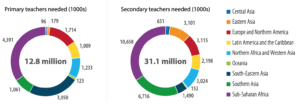“There was a sadness in his eyes and at the same time a hope, as if he knew that his efforts, though sometimes seeming futile, were planting something in the hearts of the children. He did not just teach letters and numbers; his real lesson was a love for knowledge, curiosity about the world, and nobility of spirit. He knew his work was not instantly visible, that the fruits would take years to appear, but he continued to sow, every day, with patience and faith.”
The Schoolmaster
Anton Chekhov
Can we imagine a world without teachers? Teachers play a fundamental role in education and in building a more equitable society. However, this year’s World Teachers’ Day is marked by growing concern: the global shortage of teachers. According to UNESCO, the world needs 44 million additional teachers to meet Sustainable Development Goal (SDG) 4, which aims to ensure quality education for all by 2030. This challenge affects both developed and poorer countries, and if urgent action is not taken, the repercussions for future generations will be devastating.
In the Global Teacher Report, UNESCO draws attention to the scale of this crisis and offers clear solutions for governments to address the problem. How can we reverse this trend? The recipe is simple—almost obvious. Through a combination of policies that improve working conditions, increase salaries, and strengthen training. Today, more than ever, the future of global education depends on bold and effective decisions. Let’s take a closer look.
How can we reverse this trend? The recipe is simple—almost obvious. Through a combination of policies that improve working conditions, increase salaries, and strengthen training.
Global Outlook
The teacher shortage is not an isolated problem nor exclusive to developing regions. While it is felt more acutely in areas of rapid population growth, such as Sub-Saharan Africa, which faces the most severe shortage, and South Asia, the lack of teachers affects countries across all income levels. The UNESCO report highlights that by 2030, an additional 44 million teachers will need to be hired to meet global primary and secondary education demands.
Of these 44 million, approximately 70% are required in secondary education, with even greater demand in rural and marginalised areas, where educational systems are already overburdened. The teacher shortage directly impacts the quality of education, with effects extending to student demotivation, increased inequality, and the weakening of national economies.

Source: UNESCO and TTF, 2024. Global Report on Teachers: Addressing teacher shortages and transforming the profession. Paris: UNESCO.
As we have mentioned, the most affected region is Sub-Saharan Africa, where population growth has led to increasingly overcrowded classrooms. By 2030, it is estimated that this region will need around 15 million additional teachers just to meet primary and secondary education demands. Meanwhile, South Asia, with a projected need for 7.8 million teachers, also faces significant challenges.
In Europe and North America, uncompetitive salaries and poor working conditions have made it difficult for education systems to retain their teachers. In this region, approximately 4.8 million teachers will be needed by 2030, highlighting the global nature of the problem and the need for solutions tailored to local contexts.
In Latin America and the Caribbean, 3.2 million teachers are needed, most of them (2.8 million) due to staff attrition. The current recruitment target represents 60% of the goals set in 2016, indicating the need to intensify efforts.
Underpaid, Demotivated, and Unsupported
The teacher shortage stems from various deep-rooted causes. It is not simply a matter of numbers but a series of structural factors that are undermining the teaching profession.
One of the main factors explaining the lack of teachers is low pay. In many countries, teachers’ salaries are far below those of other professions requiring similar qualifications. For example, in 20 countries in Sub-Saharan Africa, teachers earn an average of less than $7,500 per year, making it nearly impossible to meet basic family needs. In developed countries like Hungary and the United States, teachers also earn significantly less than in comparable professions, discouraging young people from entering the teaching profession.
But it’s not just low pay driving teachers away from the classroom. Overcrowded classrooms and a lack of adequate educational resources create a very difficult working environment. The student-teacher ratio has decreased globally since 2000, but in regions like Sub-Saharan Africa, it remains critical, with 56 students per teacher in some rural areas. This increases teachers’ workload and reduces their ability to provide quality education.
Another key issue is teacher attrition. According to the report, dropout rates in primary education nearly doubled between 2015 and 2022, from 4.6% to 9%. Many teachers leave the profession within the first five years, due to overwork, poor working conditions, and lack of professional support. Dropout rates are higher in secondary education and in regions with challenging economic conditions. The fact that teachers are leaving their posts at such a rapid rate exacerbates the shortage.
This teacher shortage is not a homogeneous phenomenon. In many countries, rural and marginalised areas suffer from extreme shortages, while urban areas may even have an excess of teachers. In countries like Zimbabwe, nearly half of rural science teachers are inadequately trained, exacerbating existing inequalities between rural and urban students.
The report also highlights that the subjects most affected by the lack of qualified teachers are Science, Technology, Engineering, and Mathematics (STEM), as graduates in these areas find more lucrative opportunities outside of education.
Consequences of the Shortage: The Domino Effect
The impact of the teacher shortage is deep and far-reaching. It affects not only the teachers, who face difficult working conditions and growing demotivation, but also the students (let’s not forget that the quality of teachers is one of the most important factors in students’ educational outcomes), and ultimately society as a whole.
Increased Workload. When there is a teacher shortage, the remaining teachers are forced to take on more responsibilities, increasing their workload and affecting their emotional and physical well-being. This often leads to burnout, stress, and a higher dropout rate.
Educational Inequalities. The teacher shortage affects rural areas and marginalised populations more severely, perpetuating educational inequalities. Students in these regions often have less access to qualified teachers, resulting in lower quality education and poorer future preparation.
Quality of Education. Since teacher quality is a crucial factor in students’ educational outcomes, teacher demotivation and burnout negatively affect student learning.
Social and Economic Impact. A lack of quality education for students affects society as a whole, as less-educated individuals have fewer opportunities, which could lead to inequality, economic problems, and other social challenges. In addition to the social consequences, the teacher shortage has a direct economic impact. Teacher turnover generates high costs for education systems, as it involves continuous spending on training and hiring new staff.
How Can Administrations Tackle This Shortage?
While the outlook is concerning, the report also offers several practical solutions that governments can implement to address the teacher shortage.
Increase the Attractiveness of the Profession
One of the most urgent points is to improve the attractiveness of teaching. Governments must offer competitive salaries and working conditions that make teachers feel valued and supported. This involves not only raising salaries but also offering additional incentives, such as opportunities for professional development and access to modern teaching resources. Recently, countries like France and Brazil have made significant efforts to increase teachers’ salaries. In Brazil, for example, basic education teachers received a 33% pay rise in 2022. Such initiatives not only help retain teachers but also attract new professionals to the sector.
Strengthen Training and Professionalism
Teacher training is another key aspect of addressing the shortage. Education systems must provide continuous training and support throughout teachers’ careers. The report emphasises that it is essential for teachers to have access to professional development programmes that keep them updated and motivated. Promoting the professionalism of teaching also involves giving teachers greater autonomy and participation in decision-making. In this sense, teachers should not be seen merely as transmitters of knowledge but as agents of change who can influence the improvement of their educational environments.
Inclusive Policies for Teacher Retention
To reduce high dropout rates, governments must implement comprehensive policies that address the structural causes driving teachers out of the profession. This includes improving the working environment in schools, providing emotional and psychological support to teachers, and ensuring that teachers have access to a network of collaboration and support within their communities. It is also important to implement policies that promote gender equality in the teaching profession. In many regions, women remain underrepresented in STEM subjects and in leadership roles in education. Increasing female participation in these fields not only helps address the shortage but also enriches the educational environment with diverse perspectives.
More than Words
World Teachers’ Day serves to recognise, once a year, the irreplaceable role teachers play in society. However, the reality is that we are facing a global crisis that threatens the future of millions of students, and if governments do not act decisively to address the teacher shortage, we risk leaving entire generations behind.
The good news is that solutions are there and within reach. Through investment, improving working conditions, and implementing inclusive policies focused on teachers’ well-being, it is possible to reverse the crisis. The future of education depends on teachers, and today, more than ever, we must support them so they can fulfil their fundamental role in building a more just and equitable world.






